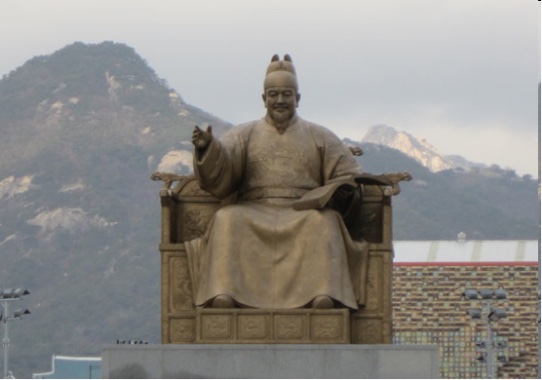The pragmatic and innovative Choe Sejin — 15th-16th c. Korean phonetician, translator, and interpreter
« previous post | next post »
[This is a guest post by S. Robert Ramsey]

The Statue of King Sejong in Downtown Seoul.
The brilliance of good king Sejong (1397-1450) overshadows another great mind of Joseon Korea, a middle-class man named Choe Sejin (1465-1542).
Make no mistake: Sejong deserves every glowing tribute Koreans have ever given him. Yes, he created the astonishing Korean writing system (now called Hangul), all by himself, without the help of some royal “committee,” as Western skeptics have long claimed. Moreover, he did so for the purest, most admirable of reasons. As Sejong explained in 1446, his intent was to provide access to learning and literacy for people who had always been denied such access: the poor, the underprivileged, women and girls.
But for his part, Choe Sejin accomplished things that Sejong did not—or could not do. Sejong was a thinker, an intellectual, who understood the phonological workings of language as perhaps no other person of his time did. With his new alphabet, Sejong developed theoretical models for how Koreans should pronounce words of Chinese origin, and he devoted major resources into compiling dictionaries to propagate those pronunciation models.
Choe Sejin, on the other hand, was a practical man far less weighed down by a pursuit of the ideal. Instead, his dictionary was a compilation of actual pronunciations—that is, of how people actually spoke, not how he thought they should speak. It was the first such dictionary ever produced in Korea.
As a teacher of Chinese to diplomats, Choe wrote textbooks of Chinese that were charming vignettes of Ming-dynasty Chinese life—in one case, a tale about ‘Interpreter Pak’ on his way from Seoul to Beijing, chatting with local Chinese along the way. The dialogs in these stories were transcribed phonetically with Hangul and translated. Though not widely known in China, his writings constitute unique records of spoken Chinese in the Ming dynasty. No other work, produced in China or anywhere else, has such information.
As a pragmatist, Choe also wrote down easy descriptions of Korean sounds and tones; he even gave the Hangul letters the names and dictionary order still used in Korea today.
No record of Choe Sejin’s life has been preserved; no images of him exist. Only a few specialists even know his name. His importance to Korea could never be compared to that of Sejong.
And yet, Choe Sejin richly deserves to be remembered as one of the most innovative, pragmatic, and brilliant minds of Korea’s golden age.
Selected readings
- "Women's Romanization for Hong Kong" (8/17/19)
- "Korean inputting on cellphones" (4/8/19)
- "Missionary Linguistics; the joys of interpreting" (12/25/21) — especially this comment
David Marjanović said,
April 22, 2022 @ 6:48 pm
"Everyone thinks King Sejong created the Korean alphabet so that people could write in the vernacular language, but I have a hunch that at least as great a part of his motivation was so that he could push his peevish ideas about how to pronounce Chinese characters correctly in the Korean style according to the classic Chinese rhyme books."
– the last of 3 comments on this topic, the first being here
Terpomo said,
April 23, 2022 @ 4:01 pm
I mainly knew him for 訓蒙字會, which seems a bit old-fashioned to our modern sensibilities but was a pretty important textbook at the time.